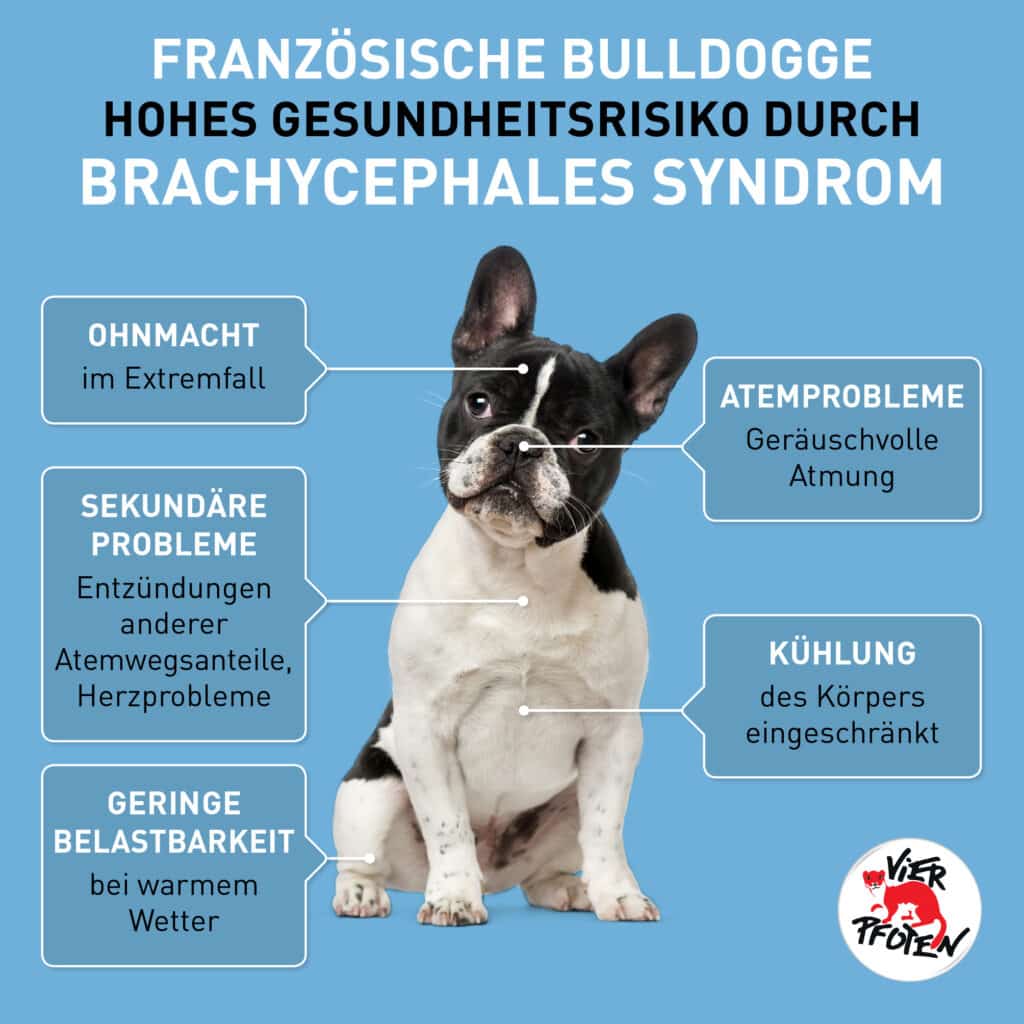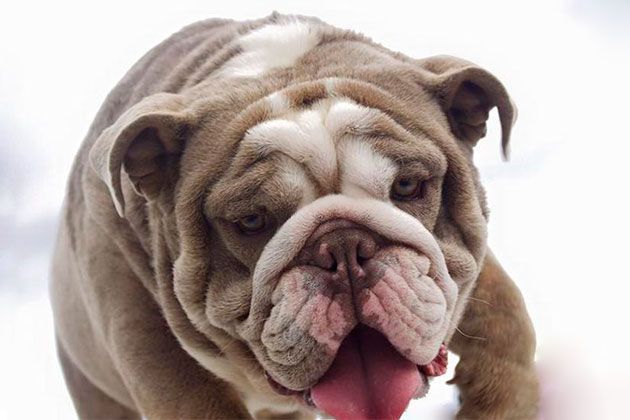
Brachiocephalic Syndrome in Dogs and Cats

Perhaps you have noticed that dogs, and even cats with shortened noses, often sniffle, grunt, and snore? Let’s try to figure out why this happens and in what cases help is needed.
Brachiocephalic Syndrome is a set of clinical signs indicating impaired respiratory function that occurs in dogs and cats with a shortened facial skull. Such animals are called brachycephals. Shortening of the facial part of the skull in brachycephals usually leads to other anatomical and pathogenetic anomalies:
- discrepancy between the size of the lower jaw and the size of the upper and the formation of a malocclusion.
- excessive crowding of the teeth in the upper jaw, leading to their displacement in the process of growth. There is not enough space in the bone for dental alveoli (the spaces where the roots of the teeth are located), the teeth can be turned by 90 ° or more, they can stand out from the general row;
- permanent traumatization of the lips and gums by improperly positioned teeth;
- Dental crowding creates favorable conditions for the development of bacteria that form plaque and calculus and cause periodontal disease, and the animal may experience chronic pain.
Excessive amount of soft tissues of the head compared to the size of the skull:
- abundant skin folds on the muzzle can lead to diaper rash, infection, foreign objects getting stuck;
- irregular structure of the nasolacrimal canal, as a result of which the tear constantly flows outward, forming dirty “streaks” on the muzzle;
- stenosis of the nostrils – i.e. their narrowness. Creates some difficulty in drawing in air. In the case of severe constriction – up to complete obstruction when trying to breathe deeper.
- hyperplasia (growth) of the soft palate. The soft palate sags behind the epiglottis, blocking the entry of air into the trachea. Vibration of the soft palate in the pharynx causes swelling and inflammation, further impairing airway patency.
- a flattened, narrowed (hypoplastic) trachea also creates an obstacle to air flow;
- hyperplasia and eversion of the vestibular folds of the larynx (“pockets”, “tracheal sacs”) lead to the collapse of the larynx;
- decreased stiffness of the cartilage of the larynx;
- violation of thermoregulation – the inability to breathe through the mouth, a tendency to overheat and the inability to correct changes under the influence of high temperatures;
- swelling and swelling of the mucous membrane of the upper respiratory tract, causing them to lose their protective functions;
- obstruction causes increased pressure in the airways and insufficient supply of oxygen to the blood.
- increased pressure in the upper respiratory tract causes vasoconstriction (vasoconstriction primarily in the lungs), which leads to pulmonary hypertension and the development of right-sided heart failure (increased load on the right atrium and right ventricle).
- heart failure can become acute in the absence of normal oxygen supply and elevated body temperature, and can also lead to pulmonary edema.
- pulmonary edema, asphyxia (suffocation) and acute heart failure without emergency assistance lead to the death of the animal.
The brachycephalic breeds include Persian cats, exotic breeds, and British cats can also have a similar type of muzzle. Dogs with a shortened facial part of the skull: bulldogs, pugs, petit-brabancon and griffon, shih tzu, Pekingese and others.
What causes brachiocephalic syndrome
The root cause lies in the shortening of the front of the skull. Because of this, there is a deformation of the airways of a dog or cat. Due to difficulty breathing, edema and inflammation of the mucous membranes often occur, which again leads to tissue hyperplasia, their change. There is a kind of vicious circle. The situation is aggravated by improper breeding of animals. Increasingly, breeding tends to snub-nosed, and many breeds are becoming more and more short-nosed, which significantly impairs the quality of life of animals. Symptoms are most pronounced at 2-4 years of age.
Clinical signs
The brachiocephalic syndrome interferes quite strongly with the life of both cats and dogs. Not all owners notice changes in the condition of their pet. Sometimes this is due to the gradual development of symptoms, and sometimes it is simply attributed to the characteristics of the breed – “we were told that all pugs breathe like that.” However, a competent owner must evaluate and monitor the condition of his pet. Signs of brachycephalic syndrome:
- Visible constriction of the nostrils.
- Fast fatiguability.
- Dyspnea.
- Labored breathing.
- Snore.
- Attacks like suffocation on excitement or physical activity.
- Difficulty inhaling: sticking of the nostrils, involvement of additional respiratory muscles, pulling the corners of the lips (inspiratory dyspnea);
- Pale or bluish color of the mucous membranes.
- Temperature increase.
- Salivation.
- Nosebleeds.
- Difficulty swallowing, nausea and vomiting.
- Bloating.
- Cough.
Diagnostics
Symptoms of brachiocephalic syndrome may be similar to other pathologies. It is important to differentiate them. Even the owner himself can easily see the narrowing of the nostrils. However, we recommend that you still consult a doctor, as this may not be the only problem. After the examination, the doctor will conduct auscultation-listen to breathing. Dogs with brachiocephalic syndrome are more likely to have inspiratory dyspnea. In some cases, to identify signs of hypoplasia, tracheal collapse and exclude complications in the form of bronchitis and pneumonia, an X-ray examination of the chest cavity and neck is required. It is possible to visualize the soft palate, trachea, nasal cavity from the inside only with the help of an endoscope, a special device in the form of a tube with a camera at the end. Usually, this study, when a pathology is detected, is immediately combined with treatment, since due to difficulty breathing and the supply of oxygen to the brain, repeated giving of anesthesia and removal from it is not desirable.
Complications
Due to poor air permeability, there is a weak saturation of the blood with oxygen – hypoxia. The whole organism suffers. Severe heart failure may also occur. Due to constant edema and inflammation, pathogenic microflora multiplies, animals become more susceptible to viral diseases. The risks of severe rhinotracheitis, pneumonia, bronchitis increase, so control and timely contact with a veterinarian is necessary.
Treatment
Antibiotics and anti-inflammatory therapy may be needed to relieve acute symptoms. The rest of the treatment is usually surgical. Produce resection of the soft palate, laryngeal sacs. The nostrils are expanded using plastic surgery techniques. A collapsed trachea sometimes requires a stent. After the operation, you will also need to give antimicrobials. Surgery can greatly improve your pet’s quality of life. Of course, before this, it will be necessary to undergo a series of studies in order to make sure that there are no sharp contraindications to an early operation and to choose the right anesthetic support. At home, it is better not to expose a dog with brachiocephalic syndrome to stress, increased physical activity, and overheating. It is also recommended to prevent obesity, as it only aggravates the condition of the animal. In case of possible attacks of difficulty breathing, you can have an oxygen cylinder at home, but do not delay with surgical treatment. All animals of brachycephalic breeds should be regularly examined by a veterinarian for early detection of anatomical changes that threaten health.





